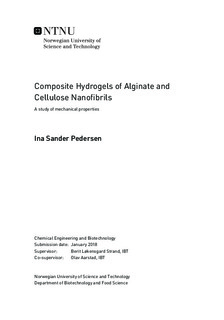| dc.description.abstract | The main focus of this thesis was to attain more information about how alginate - CNF composite hydrogels are affected by each of the two polysaccharides, in order to gain additional knowledge which could be used to manipulate these hydrogels to obtain qualities required for specific biomedical or biotechnological applications.
Firstly, light microscopy was used to examine composite gels of M. pyrifera alginate and CNF, both mechanically fibrillated and TEMPO-oxidized. Images of these hydrogels showed that the cellulose filbrils were homogeneously distributed, and no phase separation was observed for either of the two composites that were studied.
Secondly, compression tests were done on three separate composite series with calcium saturated hydrogels of 1% (w/v) alginate, extracted from D. potatorum, M. pyrifera and L. hyperborea stipe, and increasing amounts (0.00 - 0.75% w/v) of mechanically fibrillated and TEMPO-oxidized CNF. Both types of cellulose fibrils contributed to an increase in resistance against compression at low deformation (Young s modulus) and less gel shrinkage (syneresis) upon saturation, relative to pure Ca-alginates, for all three alginate composites. The largest effect was seen by TEMPO-oxidized CNF.
To examine the impact of polymer charge and increase in total dry matter on gel properties, series of hydrogels with 1% (w/v) M. pyrifera alginate and a control polysaccharide, dextran, xanthan, hyaluronic acid or additional alginate, were analysed and compared to the alginate - CNF composites. Young s modulus found for composite gels with TEMPO-oxidized CNF was significantly higher than for the control gels, confirming an effect of CNF beyond the fibril charge and increase in polymer weight alone. Further indication of interaction between alginate and CNF was established by the comparison of pure Ca-alginate gels, TEMPO-oxidized gels and composite gels, as Young s modulus of the composite gels was notably higher than the added values of the two pure gels.
Finally, a series of CNF alginate composites with various polymer composition was treated with saline solution and tested with regard to volume stability and calcium content. Weight analysis showed that TEMPO-oxidized CNF contributed to more volume stable hydrogels. Inductively coupled plasma mass spectrometry (ICP-MS) was used to determine the calcium content of a selection of composite gels. No significant difference was found between composite gels and pure alginate gels, indicating a more complex explanation than an increase in calcium binding alone. | |

